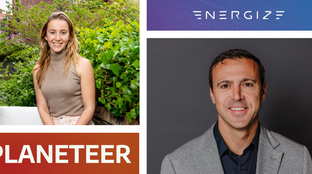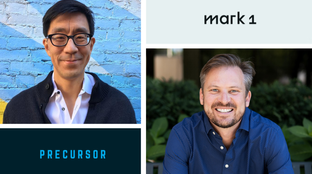
🌎 Two climate investors on raising in today's tough market
Q&As with Sophie Purdom, who just closed first-time Planeteer Fund I, and John Tough, who recently closed Energize Capital's mega-fund Ventures Fund III
A flexible capital mandate to finance the energy transition
Enabling electrification is capital-intensive and takes more than just one flavor of capital to scale. In 2017, Ben Birnbaum, John Rapaport, and Ethan Goldsmith combined their investing and operating experience in energy & mobility to create Keyframe Capital Partners, a specialized energy transition fund that flexes across the capital stack, somewhere between early-stage venture and PE/ infra. They’ve seen, and done it all - from Series A through E equity investments, convertible notes, asset-backed facilities, project facilities, PropCo - OpCo structures, and more. We sat down with Ben and John about developing a fund focused on flexibility, setting up the right capital structure for capital-intensive businesses, and identifying companies poised to benefit from the energy transition’s seismic market changes.
Your team comes from a variety of investing and operating backgrounds. How did you all end up joining forces to build Keyframe?
BB: Our three founding partners came together because of a common curiosity in vehicle electrification inspired by each of our prior jobs. We were each independently seeking answers to who was building the infrastructure—and how. Our inability to answer either question led to our first investment thesis that fleets would go through a step-change in vehicle electrification, which would create a massive hyper-local electricity need and disrupt distribution grids. Before we were even a fund, we decided this was a problem we could work on solving.
Our first investment together was starting a company called Terawatt Infrastructure in 2018, where we acquired assets for future redevelopment into charging hubs for EV fleets. While building TeraWatt to an operating scale, we kept working segment by segment on a similar sort of thinking: where will technology and regulatory change drive chaotic market disruption? Where can we apply our creativity and experience in capital structuring to unlock opportunity?
From there, we had enough of a view on the type of firm that we wanted to build, so that’s when we raised Keyframe’s first dedicated fund and started investing out of it in January 2020.
Why build a new climate fund now?
JR: When I started in 2004 at Bain Capital, energy and transportation were spaces that were specifically picked for me to cover because they were seen as truly distinct. Over time, as the relationship between those spaces deepened, the skill sets needed to cover them started to converge as well. At the same time, investment firms were getting bigger. Recognizing this, we saw a gap in the market that we believe still exists today. In order to be successful in spaces that are converging, you need three core things: (1) ability to invest with flexibility, (2) ability to move fast, and (3) ability to write smaller check sizes into emerging opportunities. Simultaneous flexibility, speed, and small sizes requires a dedicated combination of operator experience and investor expertise.
BB: Our first fund didn’t set any expectations or have a specific target that energy transition was going to be the main focus. The issue that John described—which we saw as a problem in the market that we felt like we could solve—was firms that could invest between $25M to $75M but also bring the flexibility of investing and operating thinking. We just found that to be so continuously prevalent in energy transition that we ended up investing ~80% of our first fund in energy transition. In our latest fund, we’ve gotten more intentional in that focus.
Do you still see a gap at the $25-75M investment round?
JR: We do, but it’s not just check size. It's a combination of factors where a company needs something different from the skillset that traditional VC brings to the table, but also at a check size that isn’t where the bigger industry-focused private equity and infrastructure capital can play. We see that as the place with the least competition. But our mandate is wide, so we’ll go into other places as appropriate.
BB: In energy transition, there are many non-B2B SaaS business models that when they go to take their next step of capitalization, require specialists to roll up their sleeves in helping scale that kind of business model—EV charging is a simple example that’s super capital intensive.
How do you fit into gaps in the climate capital stack?
JR: We’re looking for companies that have a really attractive value proposition, but—because of their stage, complexity, or some other factors—don’t yet fit neatly into a narrow funding bucket.
BB: We attempt to work with these companies to help them conform to capital market expectations so they can continuously access that capital to scale. That can range from as simple as a venture equity investment, and working with a team on hitting the right operational benchmarks for infrastructure or later-stage corporate capital, to as complex as a novel-asset financing. We have the flexibility with our funds to do things like help a company with its initial project capitalization—putting the right contracting and operational processes in place—that somebody in a larger firm says one day, “Oh, that looks normal to me.” And can then invest hundreds of millions of dollars in that. To give you a sense, just in the past three years, we’ve led Series A through E equity investments, convertible notes, asset-backed facilities, project facilities, PropCo - OpCo structures, and more.
JR: Structured finance, in particular, is a place where we have real internal expertise.
Talk to us about the money. What does your LPs base look like and what does your check size look like?
JR: Keyframe’s investors are all institutional, and our capital comes from a relatively discrete number of LPs—all of whom are financially oriented. We typically target investments of $25 to $75m, though have the ability to scale up (and sometimes down) when the situation is appropriate.
Do you use any standardized diligence metrics?
JR: There is no metric that will make us invest in a company. If there was a way to check boxes and succeed, we’d all be out of jobs. We’re very deeply focused on understanding a company’s “fully loaded business equation.” There’s a really strong correlation between companies who deeply understand their own business equation and their future success.
What are the most important criteria in your decision-making process?
BB: We start with an industry segment like energy efficiency and create a thesis around market change and disruption, generally driven by technology or regulatory change.
JR: Then we come up with topics to investigate in the space by applying a set of evaluation criteria ranging from tangible to intangible market selection factors that give us confidence we’ll be hunting in opportunity-rich waters, some examples of those are:
BB: From there, we’ll identify segments, meet 100 people, learn, be wrong half the time. Then when we find a segment where all those factors are driving change and opportunity, that’s where you’ll see us make a number of investments. Past deep dive areas for us include fleet electrification, building operational and energy efficiency, and brown to green (i.e. CCUS, hydrogen).
How did that framework apply to your investment in Sealed?
JR: One of our core theses for many years as a firm has been that as loads and generation get more complex, the value of having buildings that are thoughtful about their energy usage and more responsive to the grid goes up. In 2018, we thought that energy efficiency has a really strong, completely unsubsidized return profile and we identified home electrification as increasingly important.
We came across Sealed at a really interesting point in their business life. They had been around long enough to demonstrate clear product-market fit, had sold real volumes, and had a strong customer experience, but were scaling via partnerships with utilities which took the ability to grow outside of their hands. The investment community was concerned about scaling this new asset class from a financing standpoint, since contracts with customers were effectively energy efficiency-as-a-service. Sealed didn’t call it that, but that’s what it was.
That situation checked a lot of boxes for us. We thought there was a lot of, candidly, low-hanging fruit around helping their team evolve their contract set and how they approach customers, so that when they have the next round of conversations with project capital, it’s going to be a really easy conversation. Sealed has successfully moved the business model away from utility partner-led growth to a place where they are in charge of their own destiny. They've continued to modify and adjust project capital-related characteristics so they can scale financing as the business expands into other regions and markets.
What advice do you have for founders scaling in capital-intensive businesses? More specifically, what types of financing should they be considering at different stages of their business?
BB: You have to be really clear about the full term cash flow profile of your customer implementations and contracts. Until you have strong clarity on what those cash flows look like and how they’re supported by your sales cycles and operations, you’re probably funding your business with venture equity. Both because that’s what’s available to you and allows you to maintain flexibility. If you don’t have this foresight, you may take on other types of financing that don't ultimately fit your cash flow profile, which reduces future flexibility.
JR: It’s important to work backwards from your endpoint. If your business needs financing as part of its end-state commercialization strategy, then you should be taking those steps well-ahead of when you need it. The other important aspect to this is operational maturity. The more a capital provider is looking for a stream of assets or cash flows, the more guardrails they’re going to put around how you operate. There’s a level of maturity that not all businesses need to have early on to be able to handle those restrictions in a cost-effective way.
BB: Energy consists of physical assets out in the world. If you lack perspective on how a change in technology or regulation is going to impact the way that assets are financed, you’ll miss a critical part of the picture, whether in your business model or among those of your customers.
What motivates you?
JR: We’re passionate about helping to unlock new asset classes, from a financial stability standpoint. We want to be known for being the very best investment partner. Everyone is here at Keyframe because they love investing. It’s what gets us up in the morning. Being the best investment partner means that instead of optimizing for fund size, we’re inherently going to limit our AUM growth and tailor our team and opportunity set.
BB: We know that corporate capitalization is complicated in energy transition, and we are specifically focused on problem solving with the flexibility that we have.
Don’t stack up in the traditional climate capital stack? John, Ben, and the Keyframe team want to talk to you, whether you’re just starting out, already publicly traded, or anywhere in between. The more out of the box, the better. Feel free to connect with them at [email protected]. If you’re an investor’s investor and passionate about defining and creating asset classes, apply to be Keyframe’s next Analyst.

Q&As with Sophie Purdom, who just closed first-time Planeteer Fund I, and John Tough, who recently closed Energize Capital's mega-fund Ventures Fund III

A Q&A with Precursor's David Yeh and Mark1's Julian Ryba-White, new strategic partners in the ecosystem

A Q&A with the DOE LPO director Jigar Shah and Solugen CEO Gaurab Chakrabarti